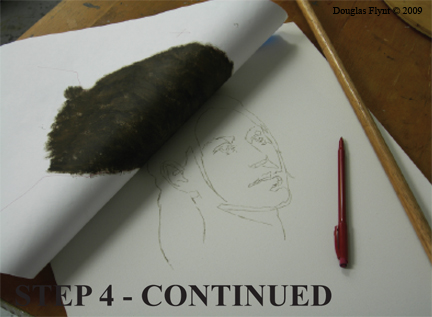(Update 1/18/12) For a French translation of this post please click here for a downloadable PDF file:
In response to my last two posts I have received questions regarding how I transfer my drawings to my linen. I have done different things over the years but usually these days I do an oil-transfer. The main reason I like doing an oil-transfer is that it doesn't introduce any other materials such as charcoal or graphite into the painting.
Here are instructions for how to do an oil-transfer. The content has been taken from a handout I made up for my painting workshops:
OIL PAINT TRANSFER PROCESS:
Douglas Flynt © 2009, all rights reserved
Here are the supplies you will need:
-Low Tack Masking Tape or Drafting Tape
-Red Ball Point Pen
-Mahl Stick or Bridge (to rest your hand on)
-Palette
-Large Bristle Brush
-Raw Umber (oil paint)
Step 1. Take a good photocopy (the darker the lines the better) of your drawing (or the drawing itself if the paper is not too thick) and hold it up to a light so that the image is facing away from you and toward the light. On the backside of the paper (not the side with the image) roughly outline the areas you will need to apply oil paint to, so that you don't have to cover the entire back of the paper.
Step 2. Put out some raw umber on your palette (do not add anything to it). Using a large bristle brush, dry brush or scumble (scrub) the paint onto the back of your photocopy (the side without the image) in the areas you outlined in step "1." Try for an even, fairly thin coat.
Step 3. Place your photocopy on your canvas or linen with the oil side face down, touching the canvas or linen. Be careful to keep the drawing aligned so that your image is not crooked. With your image carefully placed, securely tape one side of the paper to keep it from moving.
Step 4. Trace over your drawing using a ball point pen. A red pen makes it easier to keep track of where you have traced. Be careful not to rest your hand on the drawing—instead rest your hand on your mahl stick as you trace. Periodically (and carefully) flip up your image to make sure the transfer is working.
Step 5. With the tracing done, remove the photocopy and the tape. Allow the canvas to dry overnight—or more preferably, a few days.







nice explanations and pics... brings back good memories :)
ReplyDeletethank you so much for sharing!
ReplyDeleteAmazing painting Doug! Thank you for sharing.
ReplyDeleteHey Chad...yep those were the days! You sure you don't miss filling dots with a razor sharp pencil. Thanks for commenting.
ReplyDeleteEster and Jonathan, thanks for the comments and taking a look.
thank you! i always wanted to know how this was done
ReplyDeleteI though the grid method was simpler until i saw this. Wow. You light up my life!
ReplyDeleteThank you so much for sharing this!
ReplyDeleteI used to copy with charcoal the same way, but had then to repaint the copied lines on my linen surface with thinned oil paint and a brush again, let dry and remove the charcoal to avoid darkening my later paint approaches. This means a lot more work and time.
I am sure I will try your method! Thanks again...
Thanks Doug, I like that explanation. I am glad I checked this Blog...Gabriel Coke
ReplyDeleteThanks Doug! Good tip about the red pen! I've always used a proprietry Transfer Paper until now with mixed results. Not so good for canvas and introduces another layer of course. Your Oil Transfer sounds like just the ticket - will have to try next time! Thanks again, Don
ReplyDeleteThank you so much. I've been wondering how to do this.
ReplyDeletebeen reading about klee thanks now I understand.
ReplyDeleteThank you everyone for your comments! I am glad this post has been helpful.
ReplyDeleteHello Doug-
ReplyDeleteI see that we share a common love for 'stilleven'.
Any time you wish to 'trade' ideas - please do not hesitate to let me know.
my best to you, Nicora Gangi
Thank you Douglas - I have a question. I usually draw the sketch in ink but every time I try it will bleed through after a while. Yesterday I tried your method and worked very well. Now I am unsure about the next step, usually I apply a wash of turps and damar varnish over the ink sketch before painting the umber layer, but I am afraid having painted the sketch in oil that it will be dissolved by the wash...
ReplyDeleteDidn't the raw umber stick to the canvas and polute it?
ReplyDelete